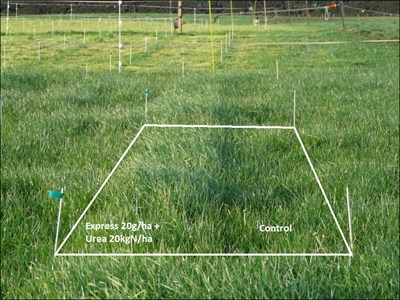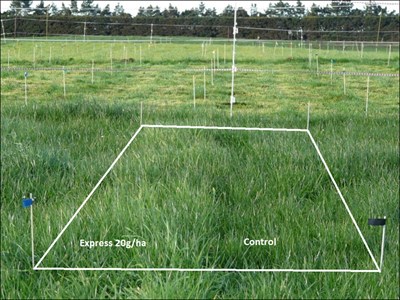Friday, 10 September 2021
The need for feed and the importance of gibberellic acid
Cooler temperatures in spring and autumn slow pasture growth rates, which leads to feed demand exceeding supply. While nitrogen (N) is commonly applied to boost pasture growth at these times, the naturally occurring plant hormone gibberellic acid (GA) can also provide benefits for pasture growth. Used either as a standalone product or in conjunction with N, gibberellic acid is suitable for application where soil temperatures remain above 7⁰C. This means warmer regions may continue to use the product through the winter to maintain pasture growth rates.
In spring on dairy farms, there is usually plenty of pasture available for the first grazing round, but pasture growth rates are often too slow for the second and third grazing rounds. In this situation, gibberellic acid and N can be used to boost pasture growth rates allowing treated paddocks to be brought back into the grazing rotation sooner.
As referenced by the trial data in table 1 below, one of the benefits of using gibberellic acid in conjunction with nitrogen is an additive effect that further boosts pasture production.
Table 1: Pasture response to gibberellic acid and Nitrogen applications in spring
| Treatment | Rate | Mean Dry Matter Yield Kg/ha | Mean extra Dry Matter Kg/ha |
| Control | - | 781 | |
| Urea | 20Kg N/ha | 1,015 | 234 |
| Gibberellic Acid | Express 20g/Ha + Widespread 1000 25ml/100L |
1,040 | 259 |
| Urea + Gibberellic acid | 20Kg N/ha + Express 20g/ha + Widespread 1000 50ml/100L |
1,285 | 504 |
Ref: Jiang et al 2011 In: Adding to the knowledge base for the nutrient manager. (Eds L.D. Currie and C L. Christensen). http://flrc.massey.ac.nz/publications.html. Occasional Report No. 24. Fertilizer and Lime Research Centre, Massey University, Palmerston North, New Zealand.
The best practice is to apply Ravensdown’s Express® gibberellic acid at 20g/ha (8g/ha GA active ingredient) to clean, recently-grazed pasture (1-5 days) when soil temperatures are between 7-16⁰C. To capture the advantage of the temporary boost in growth rate, the pasture should be grazed between 21-28 days following treatment.
Quality is important when it comes to gibberellic acid, given there is potential for some powder formulations to leave un-dissolved residues in spraying equipment. To test the solubility of Express gibberellic acid, Ravensdown commissioned an independent laboratory to compare it against another water-soluble granule of gibberellic acid.
Table 2: Solubility test results.
| Product | Solubility at 20g product/50L |
Solubility at 5g GA/L (12.5g product/L) |
|
|
Un-dissolved residue |
Time to dissolve | Un-dissolved residue | |
| Express® | <0.001% | 9 minutes | 0% |
| Alternative brand | 0.003% | > 30 minutes | 1.2% |
Ref Cotching et al 2013, COMPARISON OF THE SOLUBILITY OF TWO GIBBERELIC ACIDS FOR AGRICULTURAL USE, in Accurate and efficient use of nutrients on farms. (Eds L.D. Currie and C L. Christensen). http://flrc.massey.ac.nz/publications.html. Occasional Report No. 26. Fertilizer and Lime Research Centre, Massey University, Palmerston North, New Zealand.
No un-dissolved residues were detected from Express after five minutes at twice the recommended concentration. When tested at the recommended theoretical solubility of gibberellic acid (5g GA/L), Express completely dissolved after nine minutes. The conclusion from these tests was that there should be no issues with the solubility of Express, and the efficacy of Express will not be compromised when used as directed.
The practice of applying gibberellic acid in a tank mix with dissolved urea is becoming more popular, as there are benefits from using both at the same time. The stability of Express® was tested for up to 24 hours after mixing with water and dissolved urea solutions containing 18% N.

Ref Cotching et al 2013, THE STABILITY OF EXPRESS GIBBERELIC ACID IN COMBINATION WITH LIQUID UREA, in Accurate and efficient use of nutrients on farms. (Eds L.D. Currie and C L. Christensen). http://flrc.massey.ac.nz/publications.html. Occasional Report No. 26. Fertilizer and Lime Research Centre, Massey University, Palmerston North, New Zealand.
Express was stable (>98%) for at least 24 hours in all test solutions. Adding urea increased the pH of the Express solution from 6.1 to 8.1. There was no difference in Express stability when mixed with urea solutions with pH 4.5 to 9.
These results show that Express® gibberellic acid can be used with confidence, the soluble granules are easy to measure and mix and can be applied successfully with dissolved urea solutions.


